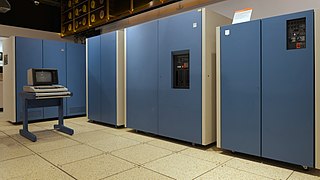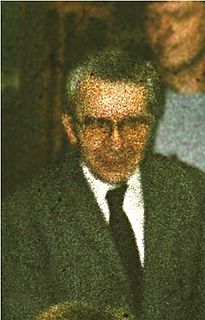Related Research Articles

AIX, is a series of proprietary Unix operating systems developed and sold by IBM for several of its computer platforms. Originally released for the IBM RT PC RISC workstation, AIX now supports or has supported a wide variety of hardware platforms, including the IBM RS/6000 series and later POWER and PowerPC-based systems, IBM System i, System/370 mainframes, PS/2 personal computers, and the Apple Network Server.
IBM mainframes are large computer systems produced by IBM since 1952. During the 1960s and 1970s, IBM dominated the large computer market. Current mainframe computers in IBM's line of business computers are developments of the basic design of the IBM System/360.

The IBM System/370 (S/370) is a model range of IBM mainframe computers announced on June 30, 1970 as the successors to the System/360 family. The series mostly maintains backward compatibility with the S/360, allowing an easy migration path for customers; this, plus improved performance, were the dominant themes of the product announcement. In September 1990, the System/370 line was replaced with the System/390.
The Conversational Monitor System is a simple interactive single-user operating system. CMS was originally developed as part of IBM's CP/CMS operating system, which went into production use in 1967. CMS is part of IBM's VM family, which runs on IBM mainframe computers. VM was first announced in 1972, and is still in use today as z/VM.
This article presents a timeline of events in the history of computer operating systems from 1951 to the current day. For a narrative explaining the overall developments, see the History of operating systems.
VM is a family of IBM virtual machine operating systems used on IBM mainframes System/370, System/390, zSeries, System z and compatible systems, including the Hercules emulator for personal computers.
CP/CMS is a discontinued time-sharing operating system of the late 60s and early 70s, known for its excellent performance and advanced features. It had three distinct versions:
VNET is an international computer networking system deployed in the mid-1970s and still in current, but highly diminished use. It was developed inside IBM and provided the main email and file-transfer backbone for the company throughout the 1980s and 1990s. Through it, a number of protocols were developed to deliver email amongst time sharing computers over alternative transmission systems.

The IBM 4300 series were mid-range systems compatible with System/370 that were sold from 1979 through 1992. They featured modest electrical and cooling requirements, and thus did not require a data center environment. They had a disruptive effect on the market, allowing customers to provide internal IBM computing services at a cost point lower than commercial time-sharing services.
z/VM is the current version in IBM's VM family of virtual machine operating systems. z/VM was first released in October 2000 and remains in active use and development as of 2020. It is directly based on technology and concepts dating back to the 1960s, with IBM's CP/CMS on the IBM System/360-67. z/VM runs on IBM's IBM Z family of computers. It can be used to support large numbers (thousands) of Linux virtual machines.

Gerrit Anne (Gerry) Blaauw was a Dutch computer scientist, known as one of the principal designers of the IBM System/360 line of computers, together with Fred Brooks, Gene Amdahl, and others.
VP/CSS was a time-sharing operating system developed by National CSS. It began life in 1968 as a copy of IBM's CP/CMS, which at the time was distributed to IBM customers at no charge, in source code form, without support, as part of the IBM Type-III Library. Through extensive in-house development, in what today would be termed a software fork, National CSS took VP/CSS in a different direction from CP/CMS. Although the two systems would eventually share many capabilities, their technical implementations diverged in substantive ways.
CP-40 was a research precursor to CP-67, which in turn was part of IBM's then-revolutionary CP[-67]/CMS – a virtual machine/virtual memory time-sharing operating system for the IBM System/360 Model 67, and the parent of IBM's VM family. CP-40 ran multiple instances of client operating systems – particularly CMS, the Cambridge Monitor System, built as part of the same effort. Like CP-67, CP-40 and the first version of CMS were developed by IBM's Cambridge Scientific Center (CSC) staff, working closely with MIT researchers at Project MAC and Lincoln Laboratory. CP-40/CMS production use began in January 1967. CP-40 ran on a unique, specially modified IBM System/360 Model 40.

The IBM System/360 Model 67 (S/360-67) was an important IBM mainframe model in the late 1960s. Unlike the rest of the S/360 series, it included features to facilitate time-sharing applications, notably a Dynamic Address Translation unit, the "DAT box", to support virtual memory, 32-bit addressing and the 2846 Channel Controller to allow sharing channels between processors. The S/360-67 was otherwise compatible with the rest of the S/360 series.
This article covers the History of CP/CMS — the historical context in which the IBM time-sharing virtual machine operating system was built.
The IBM M44/44X was an experimental computer system from the mid-1960s, designed and operated at IBM's Thomas J. Watson Research Center at Yorktown Heights, New York. It was based on an IBM 7044, and simulated multiple 7044 virtual machines, using both hardware and software. Key team members were Dave Sayre and Rob Nelson. This was a groundbreaking machine, used to explore paging, the virtual machine concept, and computer performance measurement. It was purely a research system, and was cited in 1981 by Peter Denning as an outstanding example of experimental computer science.
The history of operating systems running on IBM mainframes is a notable chapter of history of mainframe operating systems, because of IBM's long-standing position as the world's largest hardware supplier of mainframe computers.
Robert Jay Creasy was the project leader of the first full virtualization hypervisor, the IBM CP-40, which later developed into IBM's highly successful line of mainframe VM operating systems.
Remote Spooling Communications Subsystem or RSCS is a subsystem of IBM's VM/370 operating system which accepts files transmitted to it from local or remote system and users and transmits them to destination local or remote users and systems. RSCS also transmits commands and messages among users and systems.

Edson C. Hendricks, an IBM computer scientist, developed RSCS, fundamental software that powered the world’s largest network prior to the Internet and which directly influenced both Internet development and user acceptance of networking between independently managed organizations. Within IBM, the resulting network later became known as VNET and grew to 4000 nodes. In the academic community, VNET formed the base for BITNET which extended to 500 organizations and 3,000 nodes. VNET was also the networking design underpinning EARN in Europe, and NETNORTH in Canada.
References
- ↑ Tech Square
- ↑ cf. R. J. Creasy, "The origin of the VM/370 time-sharing system", IBM Journal of Research & Development, Vol. 25, No. 5 (September 1981), pp. 483-490: "It was later renamed the IBM Scientific Center"
- ↑ Melinda Varian, "VM and the VM Community: Past, Present, and Future", Princeton University Office of Computing and Information Technology, April 1991, pp. 22-50: "The Births of System/360, Project MAC, and the Cambridge Scientific Center"
- ↑ Melinda Varian, VM and the VM Community: Past, Present, and Future, April 1991, page 50